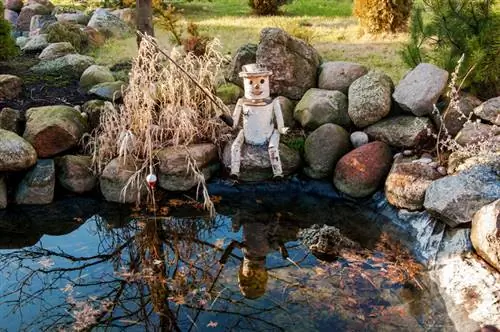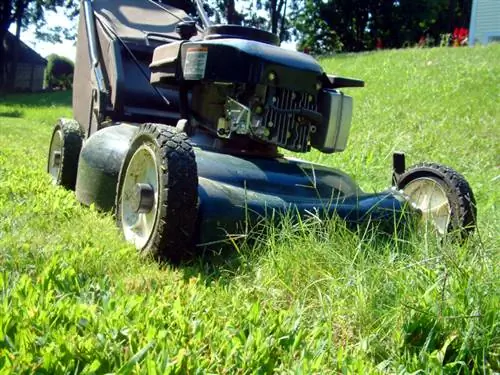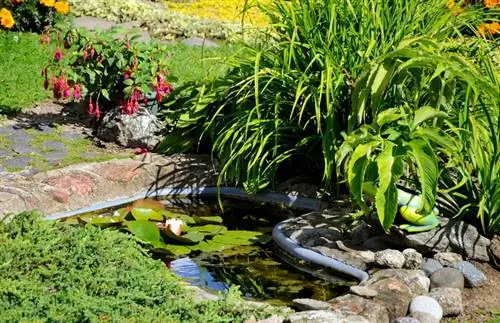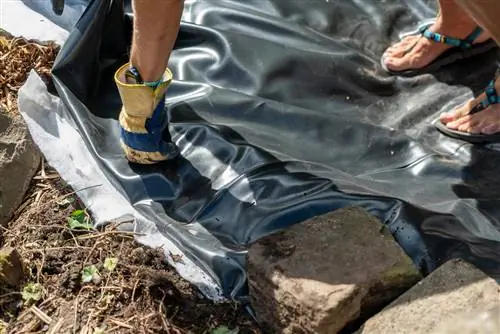- Author admin [email protected].
- Public 2023-12-16 16:46.
- Last modified 2025-01-23 11:21.
Even the highest quality pond liner can get a hole due to unfortunate circumstances. Read our article to find out how you can repair the different types of pond liners, what you need and where repairs are problematic.

How to repair pond liner?
To repair pond liner, locate the damaged area, clean and dry thoroughly. Use appropriate PVC, EPDM or PE adhesives and patches, ensure there is at least 10-15 cm overlap and press the patch firmly. Allow the glue to dry for at least 1-2 days before refilling the pond.
Types of pond liners
The most commonly used pond liner, which is also used most by professional landscaping builders, is PVC film. It has some disadvantages that you should definitely consider before using it.
Other slides are also used:
- EPDM film
- PE film (slightly better environmental properties than PVC film
- special geotextiles, the best alternative in terms of properties
Depending on the type of film, different repair methods are used. Repairing older PVC films becomes problematic (after a few years).
Gluing is problematic in this case because the film changes chemically after a few years and adhesives no longer hold well. If there is any damage or a hole here, you have to take into account that the film may no longer be completely sealed. This is also a point that actually speaks against the use of PVC films.
Search the damage location
In most cases, a leak in the film or a hole can be recognized by loss of water in the pond.
Check alternative causes
First of all, especially if the pond is relatively new, a design error must be ruled out as the cause of the water loss. This can be the case, for example, if the edge of the pond liner endsbelow the surface of the earth.
The filter system can also leak under certain circumstances. Check all hose connections here.
Heavily planted edge areas can be the cause of high evaporation in summer, especially if marsh plants are present in large quantities (sedges, reeds, cattails).
If all of this is ruled out, you can start looking for the damaged area.
Find the elevation of the damaged area
Fill the garden pond completely and mark the water level daily. The water level will drop very quickly up to the level of the damaged area, then significantly more slowly.
Once you have found the right altitude, carefully scan the surrounding areas. Most of the time you can feel the cause.
Repair damage
Leaks always have to be masked over a very large area; expect overlaps of at least 10 - 15 cm. You may also need to reline the damaged area beforehand (especially if there was a foreign body underneath that caused the hole). It is best to use pond fleece for lining.
PVC film repair
It is best to stick a sufficiently large patch on the damaged area. To do this you need a PVC glue (€19.00 on Amazon). The area must be very clean and dried well before gluing. Please note that the adhesive will probably no longer stick as well to older films.
Repair of EPDM films
EPDM film can be repaired in two ways: on the one hand with special glue and special adhesive tape, and on the other hand with liquid pond liner. Both methods are very easy to use and usually work without any problems. The film is simply applied to the damaged area in several layers, allowing each individual layer to dry.
Repair of PE films
There are also special repair adhesives for PE films. You cannot use liquid pond liner here.
Tip
Make sure that when sticking the patches you always press them on as firmly as possible, preferably with a wallpaper roller. After repairing the liner, the pond should not be filled for at least 1 - 2 days.






